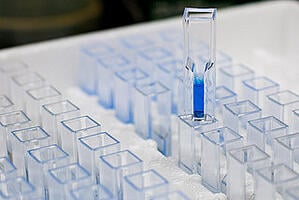 Which protein assay should you choose for your experiment – the BCA (Bicinchoninic Acid) protein assay or the Bradford protein assay? Since there is practically not a single protein assay method that is perfectly specific to particular proteins or sensitive to all protein types, your success will ultimately depend on three important factors:
Which protein assay should you choose for your experiment – the BCA (Bicinchoninic Acid) protein assay or the Bradford protein assay? Since there is practically not a single protein assay method that is perfectly specific to particular proteins or sensitive to all protein types, your success will ultimately depend on three important factors:
- The compatibility of the protein assay method with the sample type and components
- Using an appropriate assay standard
- The ability to control the remaining limitations of the chosen assay method
In addition, you need to consider protein-to-protein uniformity, sample volume, the accuracy, speed and convenience of the assay, and the availability of the required equipment (spectrophotometer, plate reader) to get the required result. The presence of interfering substances should also be considered when choosing an appropriate assay method.
BCA vs. Bradford Protein Assay: Know What’s Right for You
As mentioned earlier, there is no perfect assay that can specifically and reliably determine the protein concentration across all samples. Each method has its own unique advantages, disadvantages, and limitations, so you really need to consider all the factors before making a decision.
To accommodate the most number of samples, protein laboratories routinely use the BCA and Bradford assay methods. Alternative versions of these assays are also used to accommodate particular sample needs. What are the salient features of these assays and how do you know which one to use? Here are some things you need to know.
BCA Protein Assay
With its extreme sensitivity, the BCA assay has been one of the most widely used protein assays in the lab. This method involves a two-step process – (1) the reduction of cupric ions by proteins under alkaline conditions (Biuret reaction), and (2) the chelation of BCA with the Cu+ ion.
The second reaction produces a stable, water-soluble BCA/copper complex which absorbs light at 562 nm and changes the color of the sample from blue to intense purple. The absorbance, which can be measured with a spectrophotometer, is directly proportional to the amount of protein present in the solution.
Advantages of BCA Assay
- Exhibits extreme sensitivity (up to 100 times more sensitive than the Biuret)
- Compatible with a wide range of detergents (ionic and non-ionic) and other extraneous materials
- Applicable over a wide range of protein concentrations (from 0.5 µg/mL to 1.5 mg/mL)
- Provides greater protein-to-protein uniformity and produces a low variance in color change even when different types of proteins are used
Disadvantages and Limitations
- The presence of the amino acids cysteine, tyrosine, and tryptophan may affect the accuracy of results.
- Reducing agents (e.g., DTT, 2-mercaptoethanol), copper chelating agents, lipids, phospholipids, impure sucrose or glycerol, and acidifiers may likewise interfere with the results.
- To ensure the accuracy of results, samples and known protein standards should be assayed simultaneously.
- It requires prolonged incubation time (30 minutes to 2 hours).
Bradford Protein Assay
The Bradford assay method is based on the ability of Coomassie blue to bind directly with the protein molecules in the sample, causing the dye to change its color from red (absorbance at 465 nm) to blue (absorbance at 595 nm). Aside from determining the protein content of cell fractions, this method is also ideal for determining protein concentrations for gel electrophoresis.
Advantages
- Quick and easy to perform
- Extremely sensitive and produces fairly accurate results
- Can detect a wide range of proteins (1 to 20 µg)
- Compatible with most buffers, solvents, salts, reducing agents, and chelating agents
- Doesn’t require a spectrophotometer to measure the absorbance of the sample
Disadvantages and Limitations
- Incompatible with surfactants (causes reagent to precipitate)
- Coomassie dye is highly acidic and cannot be used for proteins with poor acid solubility
- May result in high protein-to-protein variation
- High sensitivity to basic and aromatic amino acids (arginine, histidine, lysine)
- Adsorbs to glassware and quartz cuvettes, clothing, and skin






